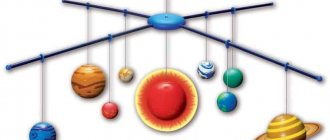The Hungarian psychologist and teacher has developed wonderful exercises and games that promote the development of mathematical concepts, as well as creative and logical thinking. Work on getting to know blocks begins in the second junior group, where kids identify one feature of an object. In the middle group, the tasks become more complicated, symbol cards appear, with the help of which children select the necessary figures. What games can be used with Dienesh blocks in older preschool age?
What are Dienes blocks
This is the name of a special didactic manual for mastering mathematics, developed by a famous Hungarian scientist.
Zoltan Gyenes devoted his entire life to this discipline. He tried to make it as understandable and interesting as possible for children. For this purpose, he specially developed the author's Dienesh system for the early development of mathematics by children. The game manual is a set of 48 geometric shapes. They are represented by elements, among which there are no repetitions. The figures are divided according to the following criteria:
- Color. Blue, red, yellow.
- Size. Small, big.
- Thickness. Thick, thin.
- Form. Circle, triangle, square, rectangle.
Methodology
Dienesh's logic blocks are designed for teaching mathematics in a playful way. Classes with them contribute to the development of memory, attention, imagination, and speech. The child develops the ability to classify material, compare, and analyze analytical information. The optimal age to start classes is 3-3 years. Working with Dienesh's logical blocks will teach your little one:
- Identify the properties of objects, name them, explain what the differences and similarities are, and support your reasoning with arguments.
- Think logically.
- It's better to talk.
- Understand color, thickness, shape and different sizes.
- Be aware of space.
- Solve educational and practical problems independently.
- Persistently pursue goals, cope with difficulties, and take initiative.
- Perform mental operations.
- Develop imagination, creative and intellectual abilities, fantasy, modeling and design skills.
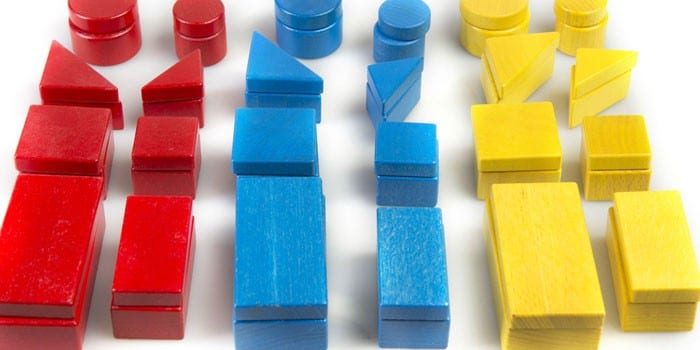
Disadvantages of the Dienes system
Strange as it may seem, experts did not find any shortcomings in Dienesh’s system . However, studying the reviews of parents who are already engaged in this system made it possible to identify such shortcomings as:
- Limited color variety in Dienes blocks;
- For older kids who solve more complex problems, one set of Dienesh blocks is sometimes not enough;
- The concept of “thickness” is incorrect, as a result of which it is sometimes difficult to explain to a child, for example, why a square is always flat;
- In Russia it is quite difficult to find albums for classes using the Dienesh system.
Subscribe to our Telegram to stay up to date with important news in the field of education.
How to work with Dienes blocks
Classes take place in several stages. Dienesh developed his method taking into account the psychological aspects of young children, so there is no need to be afraid that it will be too complex for the thinking of a preschooler. The following stages of development of mathematical abilities are distinguished:
- Free play. The goal is to teach the baby to solve unfamiliar problems using the “trial and error” method, trying out different options.
- The baby smoothly switches to playing according to certain rules. As classes progress, basic information becomes familiar, for example, “which shapes are the same.”
- Discussion, comparison of the content of mathematical games. It is necessary to select different options with related rules, but different game materials.
- Familiarization with the content of numbers. It is recommended to use maps, diagrams, tables.
- The last stage is the longest and is suitable for older preschoolers. It should offer different cards with definitions of rules that help to come to specific logical conclusions. Gradually, the baby will become familiar with such concepts as theorem and axiom.
Logic blocks
The figures themselves are the basis of Dienesh’s technique. They provide many exciting educational games for children of different ages. The main purpose of Dienesh blocks is to teach a child to understand the properties of objects. With their help, he will learn to distinguish and combine objects, and classify them. The presence of pictures and special albums will significantly diversify the number of games that you can offer your preschooler.
Cards
For classes, images are used that contain symbolic information about the properties of the figure. It looks like this:
- The color is indicated by a spot.
- The size is the silhouette of the house. A small one is designated as a one-story building, a large one as a multi-story building.
- The contours of geometric shapes correspond to the shape.
- The thickness is two images of men. The first one is fat, the second one is thin.
- In Dienesh's set there are cards with denial. For example, a multi-story building with a cross through it means that the desired figure is “not big,” that is, small.
Sets of cards can be used not only together with Dienesh blocks, but also for independent games. Working with them develops logic, the skill of decoding information using symbols. First, the child should be given the simplest game tasks to get acquainted with Dienesh cards, and then gradually complicate them. A set of images can significantly diversify classes and make them much more interesting.
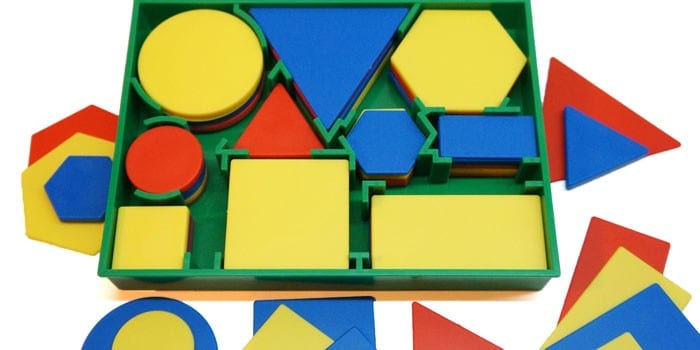
Albums
You will need to purchase several such benefits for each age range. They should be selected according to the child’s level of development, and not according to how old he is at the moment. Sometimes at 3 years old a child has the development of a 5 year old, and sometimes vice versa. The albums contain various games with Dienesh figures, diagrams and drawings according to which you can put them together. You can complicate the tasks yourself, add variety to them, focusing on the child’s reaction.
A few words about Zoltan Gyenes
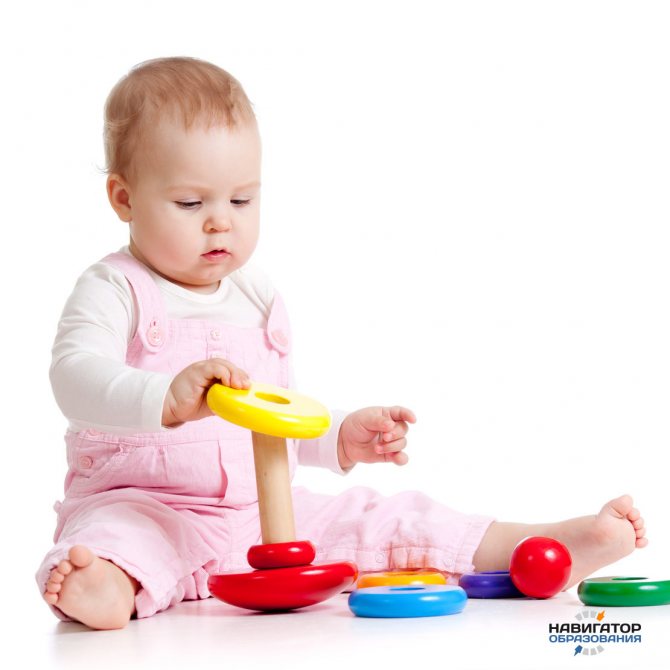
Zoltan Pál Dienes has been interested in mathematics since childhood, so there is nothing strange in the fact that he decided to devote his entire life to the “queen of the exact sciences,” as well as its popularization not only in his native Hungary, but throughout the world. Already at the age of 23, Zoltan received a doctorate in mathematics, but did not rest on this and continued his education. In order to understand the mental processes involved in solving mathematical problems, he received an additional degree in psychology.
For most of his professional career, Dienes studied psycho-mathematics (for more than 10 years he headed the Center for the Study of Psycho-Mathematics at the University of Sherbrooke). Based on his own practical experience and the results of numerous studies, he developed a unique proprietary program for studying mathematics , accessible to children of various age categories.
Zoltán Dieneš's methodology is based on various logic games, exciting mathematical tasks and educational teaching aids aimed at stimulating children's interest in mathematics, as well as the development of combinatorics, logical thinking, analytical abilities, speech, memory and attention.
Dienesha blocks for the little ones
Children from the age of two can practice logical figures. Many simple games have been developed for them. Their main goal is to teach the child to distinguish between the properties of an object and to group objects according to certain characteristics. Such activities will not only be useful, but also interesting for every child. Check out some of the most popular game options.
Samples
These are the simplest games for kids who are just getting acquainted with the Dienesh set. Example:
- Place the elements of Dienesh in front of the child.
- Let him group them according to different criteria. First he selects everything of the same color, then size, etc.
Gradually the game becomes more difficult. Invite your child to sort blocks according to two or more criteria. For example:
- Choose yellow rectangular blocks and blue square ones.
- Get all the flat figures of the same size.
- Choose thin round blocks.
- Sort out all the blue triangle shapes.
Construction
All children, without exception, adore this creative game. It is very simple, but fascinating. The child is asked to put together different figures from the elements of Dienesh, first according to the diagrams, and then without them, gradually complicating the task. Examples of objects you might be asked to construct:
- house;
- table;
- house with windows;
- herringbone;
- shop;
- stool;
- sofa;
- chair;
- steps;
- armchair;
- machine.
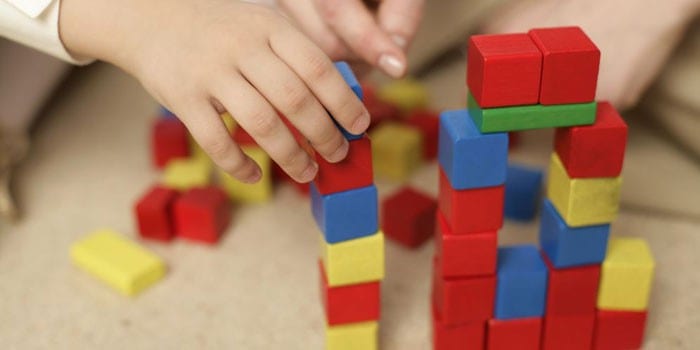
Continue the series
The game is aimed at strengthening the child’s knowledge of geometric shapes, size, thickness, and color. Thanks to her, he will learn to find patterns. Task options:
- Place the elements of Dienesh on the table in front of the baby so that each next one differs from the previous one in one way. The child independently continues this series.
- Lay out a chain of Dienesh figures so that there are no objects nearby that are identical in two respects. Invite your child to continue this series.
- Place Dienesh figures in front of the baby by color: red, yellow, blue. He will continue the series, alternating shades in a given sequence.
Feed the animals
Place several of his favorite toys in front of your baby. Let him feed each one a pair of “cookies” (blocks). Offer some conditions, for example, the bear cub should be given only red food, and the kitten should be given square food. This game resembles sampling, but children perceive it much better. It’s rare that any child refuses to feed their pets.
Games with Dienesha blocks for the older group
When the child grows up, he will be able to click the exercises for kids like seeds, and the tasks will have to be complicated. Dienesh's method for preschoolers is designed for children 5-6 years old. The exercises are more complex; not only the cubes themselves are actively used, but also cards and game albums. The tasks are aimed at developing logical thinking in an adult child and the ability to explain the decision made. Study a few games as examples, based on which you can come up with many more exercises.
Search
Give your child any figurine of Dienesh or offer to choose one yourself. Then, from the total mass of blocks, he will take out all those that coincide with the first one in one given property. Once he has mastered the game well, make it more difficult. Let the child select blocks that have two identical properties to the one originally taken. Then you can make the game even more difficult. The child must choose those blocks that do not have a single adjacent property with the first one.
Domino
This game is suitable even for several children. Rules:
- Each player receives an equal number of blocks. The order of participants is determined.
- The first one makes a move with any piece.
- The second one places a block that has one of the same properties.
- If there is no suitable piece, the participant misses a move.
- The first one to lay out all his blocks wins.
- The game can be complicated by changing the rules about the properties of the pieces being laid out. For example, you need to respond with a block that has two similar characteristics, etc.
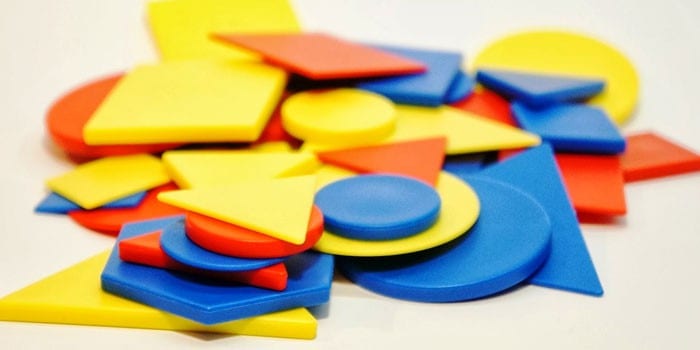
Find the odd one out
The following game will help children learn to group three-dimensional geometric shapes according to various criteria. Rules:
- Place three figures in front of the child. One of them should not have a single property in common with the others.
- Let the child figure out which block is extra and explain why and how he came to this conclusion.
- Make the task more difficult. Lay out 6 blocks. The baby must remove the extra two.
Find a match
This game will appeal to children who have already mastered all the simple tasks well. Rules:
- Place several figures in a row in front of your child.
- Offer to select a steam room for each according to a specific property.
- Make the task more difficult. Let the child try to choose a pair based not on one, but on two or three properties.
- You can initially take, for example, 10 paired elements. Place them in a bag. Let the child make the pairs himself, laying out the Dienesh figures in two horizontal rows.
Artists
To play the game you will need several large sheets of colored cardboard. They serve as sketches of paintings. To compose the composition, additional cardboard parts are needed. The game teaches you to analyze the shape of objects, compare them, and develops creative and artistic abilities. Rules:
- Based on the sketches, the kids must “paint” a picture.
- They choose the preparation themselves. It shows schematically where which blocks should be located. Thin ones will only be outlined, and thick ones will be completely painted over.
- Let the children select the missing blocks and parts cut out of cardboard to the correct places in the “sketch”.
Shop
For this task you need cards with images of objects that will serve as goods, and logical elements. The game “Shop” develops memory, the ability to reason, justify your choice, identify and abstract properties. Rules:
- A preschooler comes to a store that has a variety of card products. He has three figures that perform the function of money. You can purchase one item for each.
- The child needs to buy an object that has at least one property that matches the money figure.
- You can gradually complicate the game by offering new rules.
Let's decorate the Christmas tree
The following game helps develop the skills of ordinal counting and diagram reading. For it you will need an image of a Christmas tree and 15 cards with symbols and blocks. Rules:
- The Christmas tree should be decorated with beads in five rows. Each will contain three beads.
- The number on the card is the serial number of the position of the thread from top to bottom. The circle painted on it shows which number the bead should go, and below it indicates which element will represent it.
- Let the child hang the first row of beads, and then all the lower ones, strictly following the diagram on the card.
Game index
At the beginning of the lesson, it is necessary to explain to the child what the didactic material is and how it can be used in the game. We pour the contents of the set in front of the baby and allow him to touch, look, and play. The child uses objects from the didactic set of Z. Dienesh in different ways in play activities: lays them out, replaces one block with another, rearranges them, hides them, finds them, distributes them among toy characters, etc.
Determining the properties of an object - games for the little ones
- A box for game elements can become an impromptu “house” with “windows” corresponding to the shape of the blocks. The baby will collect blocks through special holes with interest and excitement.
- We put the elements from the set into an opaque bag or fabric bag and ask the child to identify and name an object of a given shape by touch, justify his choice by voicing the sign, then take out the required block and make sure that the result is correct.
- We lay out all the game elements in front of the child and ask them to make a systematic selection by properties, sorting separately the blocks in the shape of a circle, square, etc., then, subject to the obligatory readiness and desire of the child, you can complicate the task by adding another feature, for example, color.
- A game of sequential chain, alternating blocks according to a certain logical criterion (color, shape or thickness). The task can vary variably, for example, first we ask you to continue the logical sequence in accordance with the pattern inherent in the exercise, or remove an extra object. The difficulty level of this task can also be gradually raised by adding new game conditions.
Video: game with Dienesh's logic blocks
Identifying properties and performing a comparison operation
- Game "Count and tell how many figures."
Purpose of the exercise: to develop the ability to correctly and accurately formulate a question, develop skills in determining the properties of objects, as well as comparisons according to various parameters.
Game scenario: Two teams of players participate. The teacher lays out multi-colored blocks of various shapes and sizes in random order and asks the children to ask questions that begin with the phrase “How many...?” Each correctly asked question receives one point, and the team with the most points wins.
Possible questions: “How many small blocks?”, “How many red figures in the second row?”, “How many blue thin figures?” etc.
The simplest logical task on the patterns of one property
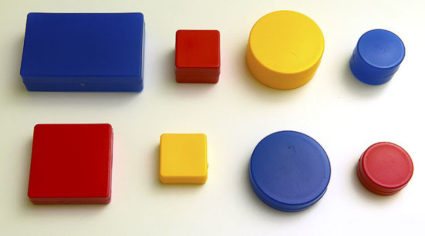
Game for learning one property
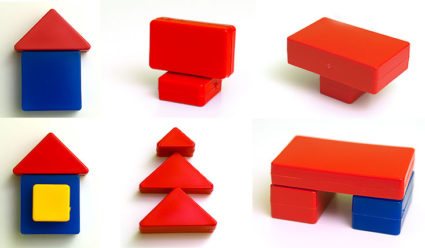
Your child will be interested in putting together such figures on their own.
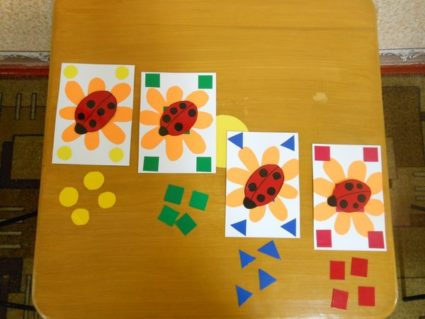
You can also use cards with geometric patterns
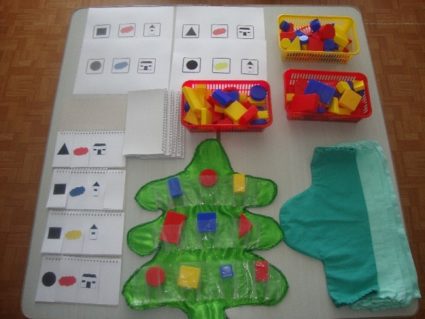
The children were told three properties of the shapes in order, starting from the first row. The child who had the required figure went out and placed his block in the right place on the Christmas tree.
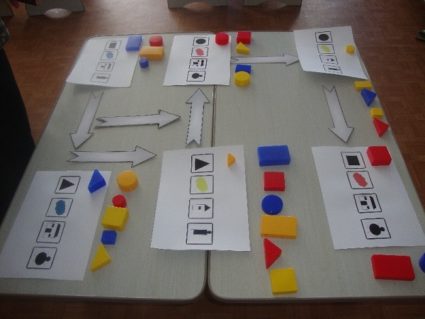
The teacher plays the role of a conductor and gives the children tickets - geometric shapes. The same blocks are already on the bus seats. The guys need to find their seat according to the ticket.

The task of the hoop is to outline the playing areas for completing the task of sorting blocks
Blocks can be used to figuratively replace any object in a game fairy tale or literary plot, for example, a large yellow round block will become an appetizing jar of honey for Winnie the Pooh, and a child’s imagination can easily turn a yellow triangle into a goldfish.
You can invite your child to give gifts to his toys, for example, a bear will like round gifts, and a doll will like triangular ones, so you need to select only the necessary elements from the entire set. The game will become more interesting if new friends appear in it, for example, the bear has his little brother, for whom, accordingly, he will need smaller gifts, and the doll has a younger sister.
- Game "Little amateur gardeners"
Each player chooses a large shape (circle, square, triangle) of his favorite color, which will become his flowerbed. Next, he “plants” beautiful flowers, throwing shapes of different colors and shapes into the circle. Our flowers can share their fabulous story about themselves, which the child will come up with. The role of colors will be played by blocks (four properties) and figures (three properties), the quantity and quality of didactic material is discussed at the beginning of the game. For example, the presenter states the conditions: “In the flowerbed you need to grow three small, red, not round flowers,” or “a large blue rectangle, a large blue circle, a large blue square.”
Working with Symbols
- Game "Let's decorate the Christmas tree with balls."
There should be a total of five horizontal rows of three balls each. The number in the picture indicates the order in which the ball is positioned; we start counting from the top of the tree. An example of filling the second row. The first ball is a large red circle, the second is a small red triangle, the third is a large red rectangle. We place the remaining balls in the same way.
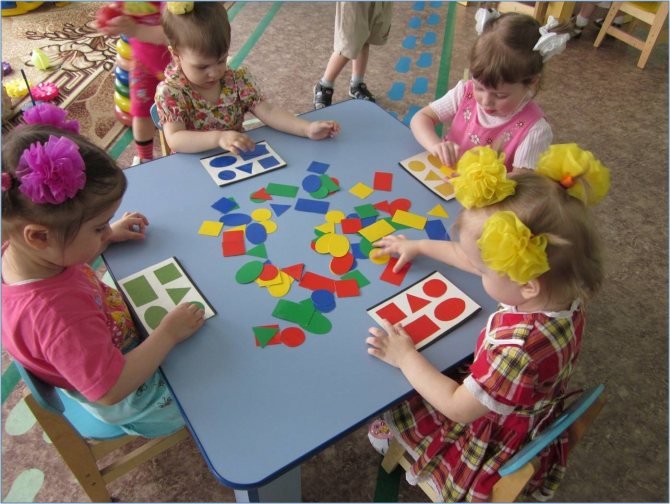
Sets of “Logical Figures” can be widely used by educators in the pedagogical process when familiarizing children with the standards of forms, teaching actions with standards
- Game "Match a Pair"
Goal: Improving the ability to visually memorize and retain information in memory, developing the ability to recognize and operate with symbolic cards.
The game involves twenty-two pictures with symbols without negation. All cards are randomly mixed and then laid out with their backs, six cards in each horizontal row. This leaves four in the bottom row.
The player turns over two independently chosen cards; if they are the same, he keeps them for himself, and then repeats his move. If the symbols of the cards are different, then they turn them over with the back side up and put them in place, trying to remember the image. All children carefully observe the manipulations with the cards, since the task of each player is to collect the maximum number of paired cards, and for this it is necessary to remember the location of the previously opened cards. Each child who enters the game repeats similar actions, the one who collects the most cards wins.
Video: educational games for children with Dienish blocks using a diagram map.
Games for systematization and logical actions
- Games with hoops.
To play the game, you will need colored ribbons or hoops that outline the area of the task so that two non-intersecting circles of different colors are formed on the floor. We explain the concepts of “inside” and “outside”. The child’s task is to place blocks of the corresponding color in each circle. The next task will relate to classification by shape, for example, we place only round blocks in a circle, and triangular ones outside. You can complicate the exercise by creating an area where the hoops intersect, thus creating three areas: left, right and general, in which the circles intersect. We ask the child to sort the blocks, for example, red ones should be in the right zone, all round ones should be in the left zone, and blue triangular ones should be in the general zone. Additionally, you can ask to place all non-red blocks outside the circles.
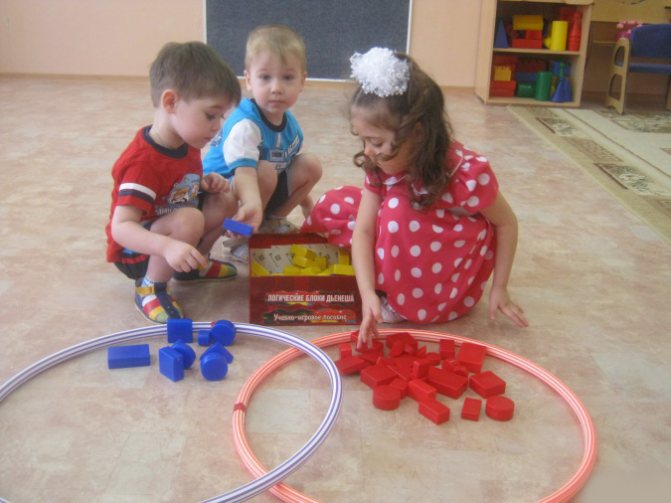
Formation of the operation of classifying blocks according to two, three, four characteristics using codes and without them. Determining intersection areas in hoop games. Development of logical thinking and attention
- Game "Baby Architect".
The goal is to develop skills in designing, decoding, reading diagrams and algorithmic maps. Additionally, you will need images of crossed out objects (“not properties”), drawings, diagrams or ready-made albums with pictures that consist of combinations of logical forms.
We draw a diagram (or take a ready-made one) to construct the building, ask the child to select building materials according to the instructions and complete the task step by step. For example, to build the first floor we will need three non-red rectangular elements, the second floor will consist of two non-yellow and non-round blocks, etc.
Video: developing concentration using Dienesh blocks (using the album)
- Game "Digital Mosaic"
The child takes a card with an example, solves it by decoding and selects the appropriate block. Then, for example, such a card means that he must take a red thick circle and place it on the tractor figure, covering the outline number six with a block.

